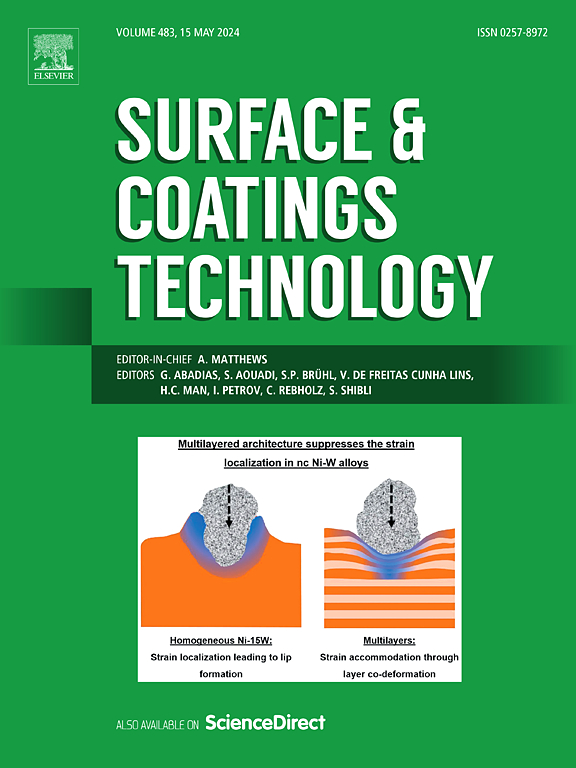CMAS resistance of high-entropy (Dy0.2Ho0.2Er0.2Tm0.2Lu0.2)2Hf2O7 in-serviced as top TBC of Si-HfO2/Yb2Si2O7/Yb2SiO5 EBCs system: an experimental and atomistic modeling study
IF 5.3
2区 材料科学
Q1 MATERIALS SCIENCE, COATINGS & FILMS
引用次数: 0
Abstract
The creation of a modified T/EBC system was driven by the absence of a proven strategy to enhance the intrinsic resistance of silicate EBCs to molten silicate deposits (CMAS). To address this, a high-entropy hafnate material with a defect-fluorite structure was designed using five rare earth (RE) elements: Dy, Ho, Er, Tm, and Lu. Quadruple-layer coatings consisting of (Dy0.2Ho0.2Er0.2Tm0.2Lu0.2)2Hf2O7/Yb2SiO5/Yb2Si2O7/Si-15 mol% HfO2 ((5RE)2Hf2O7/YbMS/YbDS/15SH), prepared by plasma spray-physical vapor deposition (PS-PVD), were deposited to protect ceramic matrix composites (CMC). These coatings were evaluated for their interfacial thermochemical stability and resistance to CMAS attack. The study revealed no thermochemical reactions at the interface between the (5RE)2Hf2O7 and YbMS layers following isothermal annealing at 1300 °C, 1400 °C, and 1500 °C. The (5RE)2Hf2O7 layer acts as a reactive barrier, resisting CMAS infiltration and maintaining the integrity of the coating. At 1300 °C and 1400 °C, reactions between the melt and the coating result in the formation of RE-garnet phases on the surfaces. At 1500 °C, RE-garnet phases were observed at the interface between the (5RE)2Hf2O7 and YbMS layers, along with the consistently observed apatite and fluorite reaction products. Most of the RE3+ ions dissolved from the (5RE)2Hf2O7 TBCs were captured by apatite, maintaining the crystallization stability of the reaction products and acting as a permeability barrier. Furthermore, melt/coating interaction models were developed using the ab initio molecular dynamics method (CP2K package) to understand coating/deposit reactions at the atomic level, including diffusivity dynamics and diffusion energy barriers. During the cooling stage, vertical mud-cracks and bifurcated microcracks are induced by thermal stresses resulting from the mismatch in coefficients of thermal expansion (CTE) between the corroded layer and the underlying layer. As CMAS continues to infiltrate the coating, a Yb-bearing apatite layer forms and gradually thickens through the dissolution and reprecipitation reactions with the YbMS. This corrosion layer introduces additional compressive stress on the unreacted YbMS layer, promoting the formation of more bifurcated microcracks. With further infiltration of newly molten CMAS, these microstructural damages accelerate the overall degradation of the coating system.
高熵(Dy0.2Ho0.2Er0.2Tm0.2Lu0.2)2Hf2O7作为Si-HfO2/Yb2Si2O7/Yb2SiO5 EBCs体系顶部TBC的CMAS电阻实验与原子模拟研究
改进的T/EBC体系的创建是由于缺乏一种经过验证的策略来提高硅酸盐EBC对熔融硅酸盐沉积物(CMAS)的内在抗性。为了解决这一问题,利用五种稀土元素:Dy、Ho、Er、Tm和Lu,设计了一种具有缺陷萤石结构的高熵铪酸盐材料。采用等离子喷涂-物理气相沉积(PS-PVD)法制备了(Dy0.2Ho0.2Er0.2Tm0.2Lu0.2)2Hf2O7/Yb2SiO5/Yb2Si2O7/Si-15 mol% HfO2 ((5RE)2Hf2O7/YbMS/YbDS/15SH)四层涂层,用于陶瓷基复合材料(CMC)的防护。对这些涂层的界面热化学稳定性和抗CMAS侵蚀性能进行了评价。在1300℃、1400℃和1500℃等温退火后,发现(5RE)2Hf2O7和YbMS层之间的界面没有发生热化学反应。(5RE)2Hf2O7层作为反应屏障,抵抗CMAS的渗透,保持涂层的完整性。在1300°C和1400°C时,熔体和涂层之间的反应导致表面形成re -石榴石相。在1500°C时,在(5RE)2Hf2O7和YbMS层之间的界面处观察到re -石榴石相,并观察到磷灰石和萤石的反应产物。从(5RE)2Hf2O7 tbc中溶解的大部分RE3+离子被磷灰石捕获,保持了反应产物的结晶稳定性,并起到了渗透屏障的作用。此外,利用从头算分子动力学方法(CP2K包)建立了熔体/涂层相互作用模型,以了解原子水平上的涂层/沉积反应,包括扩散动力学和扩散能垒。在冷却阶段,腐蚀层与下垫层之间的热膨胀系数(CTE)不匹配所产生的热应力诱发了垂直泥裂纹和分叉微裂纹。随着CMAS不断渗入涂层,与YbMS发生溶解和再沉淀反应,形成含钇磷灰石层,并逐渐增厚。该腐蚀层在未反应的YbMS层上引入了额外的压应力,促进了更多分叉微裂纹的形成。随着新熔融CMAS的进一步渗透,这些微观结构损伤加速了涂层系统的整体降解。
本文章由计算机程序翻译,如有差异,请以英文原文为准。
求助全文
约1分钟内获得全文
求助全文
来源期刊

Surface & Coatings Technology
工程技术-材料科学:膜
CiteScore
10.00
自引率
11.10%
发文量
921
审稿时长
19 days
期刊介绍:
Surface and Coatings Technology is an international archival journal publishing scientific papers on significant developments in surface and interface engineering to modify and improve the surface properties of materials for protection in demanding contact conditions or aggressive environments, or for enhanced functional performance. Contributions range from original scientific articles concerned with fundamental and applied aspects of research or direct applications of metallic, inorganic, organic and composite coatings, to invited reviews of current technology in specific areas. Papers submitted to this journal are expected to be in line with the following aspects in processes, and properties/performance:
A. Processes: Physical and chemical vapour deposition techniques, thermal and plasma spraying, surface modification by directed energy techniques such as ion, electron and laser beams, thermo-chemical treatment, wet chemical and electrochemical processes such as plating, sol-gel coating, anodization, plasma electrolytic oxidation, etc., but excluding painting.
B. Properties/performance: friction performance, wear resistance (e.g., abrasion, erosion, fretting, etc), corrosion and oxidation resistance, thermal protection, diffusion resistance, hydrophilicity/hydrophobicity, and properties relevant to smart materials behaviour and enhanced multifunctional performance for environmental, energy and medical applications, but excluding device aspects.
 求助内容:
求助内容: 应助结果提醒方式:
应助结果提醒方式:


